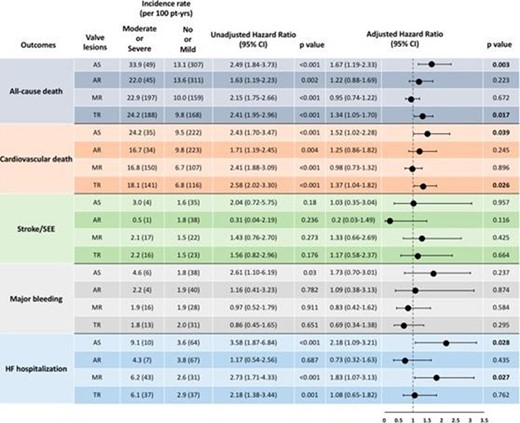-
PDF
- Split View
-
Views
-
Cite
Cite
A Samaras, E Vrana, A Kartas, G Rampidis, I Doundoulakis, G Fotos, G Efthimiadis, H Karvounis, A Tzikas, G Giannakoulas, MISOAC-AF, Prognostic implications of valvular heart disease in patients with non-valvular atrial fibrillation, European Heart Journal, Volume 42, Issue Supplement_1, October 2021, ehab724.0421, https://doi.org/10.1093/eurheartj/ehab724.0421
Close - Share Icon Share
Abstract
Atrial fibrillation (AF) and valvular heart disease (VHD) are frequently encountered in clinical practice, and often coexist, especially in the elderly population. Both conditions are associated with increased mortality and morbidity. Recent guidelines suggest careful evaluation of patients with AF and VHD due to the puzzling nature of their coexistence.
To evaluate the prognostic effect of significant valvular heart disease (sVHD) among patients with non-valvular AF.
This is a post-hoc analysis of the MISOAC-AF trial (NCT02941978). Consecutive inpatients with non-valvular AF who underwent echocardiography were included. sVHD was defined as the presence of at least moderate aortic stenosis (AS) or aortic/mitral/tricuspid regurgitation (AR/MR/TR). Cox regression analyses with covariate adjustments were used for outcome prediction.
In total, 983 patients with non-valvular AF (median age 76 years) were analyzed over a median follow-up period of 32 months. sVHD was diagnosed in 575 (58.5%) AF patients. sVHD was associated with all-cause mortality (21.6%/yr vs. 1.6%/yr; adjusted HR [aHR] 1.55, 95% confidence interval [CI] 1.17–2.06; p=0.02), cardiovascular mortality (16%/yr vs. 4%/yr; aHR1.70, 95% CI 1.09–2.66; p=0.02) and heart failure-hospitalization (5.8%/yr vs. 1.8%/yr; aHR 2.53, 95% CI 1.35–4.63; p=0.02). The prognostic effect of sVHD was particularly evident in patients aged <80 years and in those without history of heart failure (p for interaction <0.05, in both subgroups) [Figure 1]. After multivariable adjustment, moderate/severe AS and TR were associated with mortality, while AS and MR with heart failure-hospitalization [Figure 2]. AS was the only independent predictor of valve intervention during follow-up (aHR 10.78, 95% CI 4.80–24.22; p<0.001). Mixed aortic valve disease (AS+AR) had superior prognostic power across patterns of combined VHD.
Among patients with non-valvular AF, sVHD was highly prevalent, and beared high prognostic value across a wide spectrum of clinical outcomes. AS, MR, TR and mixed aortic valve disease were associated with worse prognosis.

Subgroup analyses by VHD status

Prognostic impact of valve lesions
- aorta
- aortic valve stenosis
- atrial fibrillation
- tricuspid valve insufficiency
- echocardiography
- nonvalvular atrial fibrillation
- atrium
- heart failure
- heart valve diseases
- follow-up
- inpatients
- guidelines
- heart
- morbidity
- mortality
- patient prognosis
- treatment outcome
- stressor
- older adult
- cox proportional hazards models
- cardiovascular death
- aortic valve disease mixed



